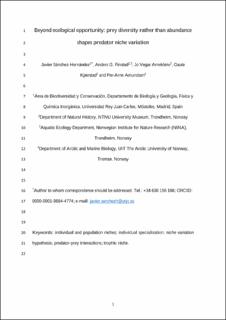| dc.description.abstract | Ecological opportunity (i.e. the diversity of available resources) has a pivotal role in shaping niche variation and trophic specialisation of animals. However, ecological opportunity can be described with regard to both diversity and abundance of resources. The degree to which these two components contribute to niche variation remains unexplored.
To address this, we used an extensive dataset on fish diet and benthic invertebrate diversity and density from 73 sampling events in three Norwegian rivers in order to explore realised trophic niches and the response of dietary niche variation along gradients of resource diversity (potential trophic niches), resource density (as a proxy of resource abundance) and fish density (as a proxy of inter- and intra-specific competition) in a freshwater top predator (the brown trout, Salmo trutta L.).
Linear models indicated that individual and population niche variation increased with increasing ecological opportunity in terms of prey diversity. However, no simple cause-and-effect associations between niche indices and prey abundance were found. Our multiple regression analyses indicated that the abundance of certain resources (e.g. Chironomidae) can interact with prey diversity to determine individual and population realised trophic niches. Niche variation (within-individual component and inter-individual diet variation) decreased with increasing inter- and intra-specific competition.
This study extends prevailing trophic ecology theory by identifying diversity, rather than density, of available prey resources as a primary driver of niche variation in fish of temperate riverine systems with no extensive resource limitation. The study also shows that ecological opportunity may mask the direction of the effect (compression or expansion) of competition on niche variation when food resources are diverse.
Our study provides novel empirical insight to the driving forces behind niche variation and reveals that diversity, rather than density, of available prey resources may be a primary driver of niche variation in freshwater fish. Our study supports the view that a broader potential trophic niche promotes broader realised trophic niche variation by individuals, which leads to individual niche diversification by opening access to alternatives resources, resulting in a concomitant rise in the realised trophic niche width of the population. | en_US |
